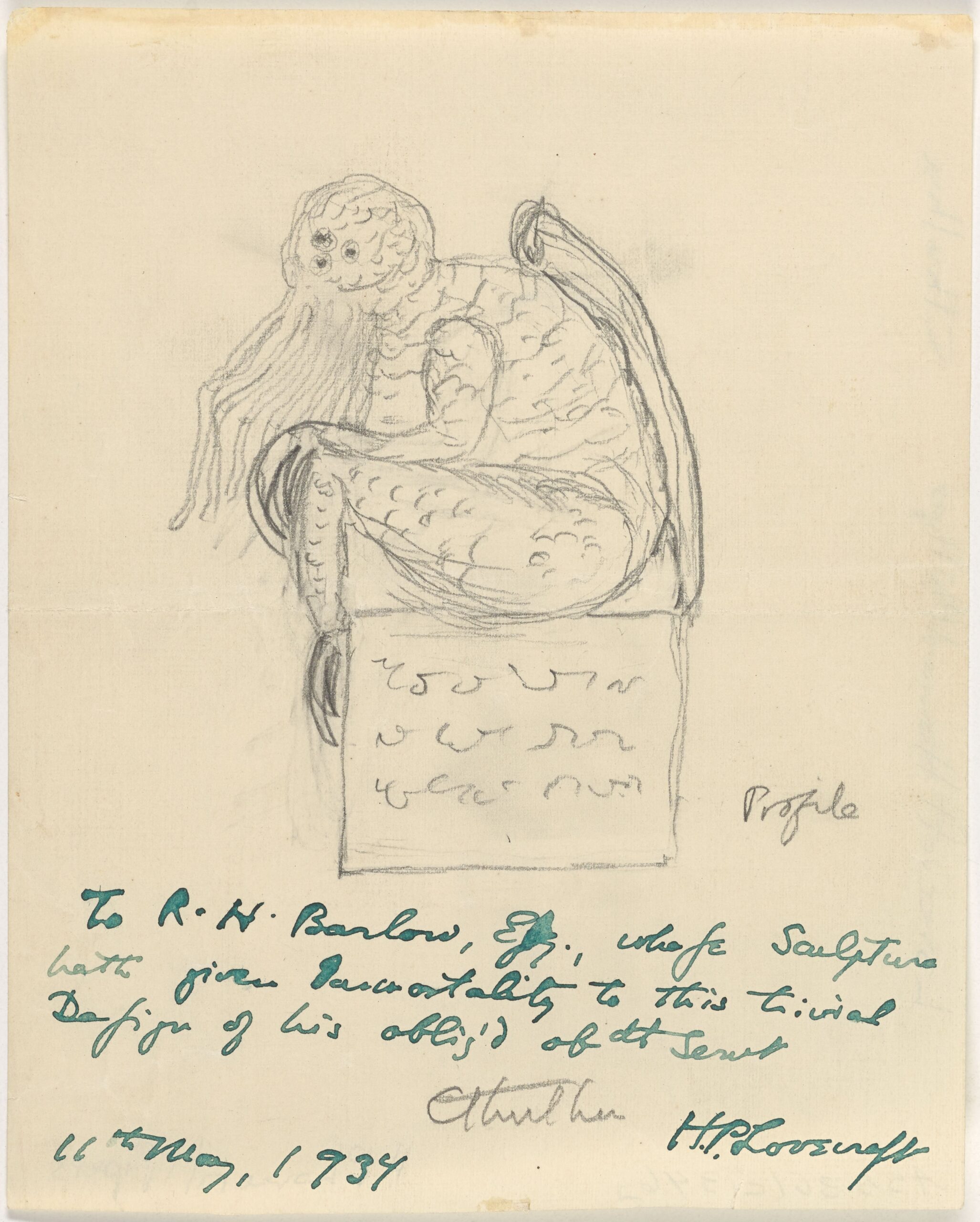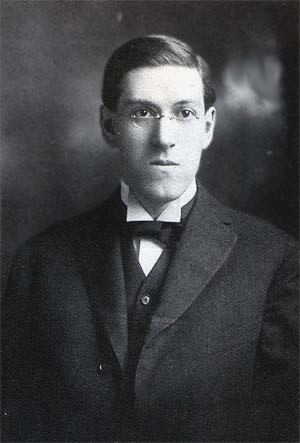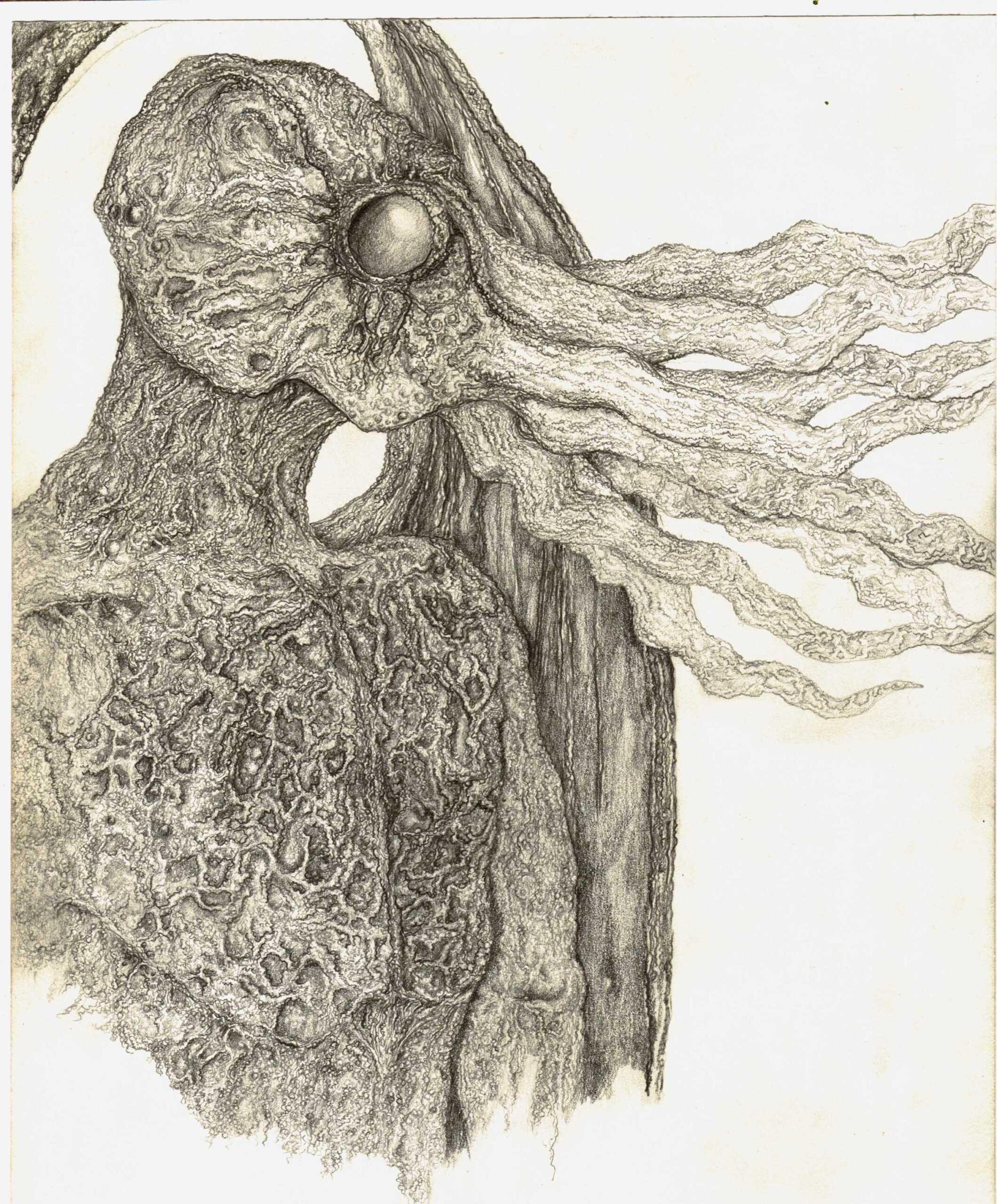Investigating an age-old question—can we separate the art from the artist?—through the lens of Lovecraftian horror, Aren Morrissey crafts a compelling story of how queer people have been able to engage with the genre in ways that embrace diversity, rather than reinforcing its history of prejudice. Delving into the work of the queer podcast Hello from the Hallowoods, Morrissey demonstrates how the genre has been subverted and reinvented by marginalized communities in order to create stories that embrace themes of found family, self-love, and accepting the unknown. Ultimately, Morrissey offers the hopeful conclusion that the bigotry of the artist need not reflect the potentiality of the art and its capacity to inspire positive change.–Yena Perice ‘26J
Inclusive Lovecraft: Queer Found Family in Exclusionary Fiction
Aren Morrissey ’28

“Canceling,” or the act of rejecting a person or piece of media because of the promotion of certain beliefs or actions, has become the go-to solution for dealing with potentially controversial individuals. Sometimes, canceling can be the right course of action, while other times it negates the possibility for change and personal growth of the individual. Additionally, when the art a canceled person has created is widely appreciated and respected, a social dilemma of whether or not to reject their creations comes into play. J.K. Rowling, the creator of the internationally beloved Harry Potter series, has been canceled by many due to her transphobic beliefs. Those who believe that trans people exist and have rights find Rowling’s beliefs unsupportable, but some have found it challenging to abandon the Harry Potter books entirely. A similar conundrum can be found with Howard Phillips Lovecraft, infamous founder of the Lovecraftian horror genre and the author of books such as The Call of Cthulhu, At the Mountain of Madness, and The Shadow over Innsmouth. This dilemma raises a complex question: can artists be separated from their art?
Despite his widespread popularity in classic literature and his significant impact on the horror genre, Lovecraft is now considered by many to have been a terrible person. His racist, xenophobic, and anti-semitic remarks—many of which can be seen in his writings—have led him to be “canceled” in today’s society. However, there is now a debate over whether the eponymous genre of Lovecraftian horror should be canceled along with its creator due to its historical engagement with bigotry. Hello from the Hallowoods, a queer Lovecraftian horror podcast written and produced by William A. Wellman, seeks to challenge the belief that any fan-written Lovecraftian horror must contain bigotry in order to truly exist within the genre. Focusing on inclusion and representation while generating a haunting main plot, Wellman creates a new environment in which listeners can enjoy Lovecraftian horror without feeling as though they are endorsing the legacy of a horrible man. Hello from the Hallowoods succeeds both as a work of Lovecraftian horror and queer media, as it defies Lovecraft’s problematic ideals while remaining true to the feeling of the original stories.

Resisting the ideals embedded in Lovecraft’s original works while honoring other crucial aspects of the genre has allowed Hello from the Hallowoods to invite minority audiences to enjoy the genre without exclusion. There are several key themes that define the Lovecraftian genre. These include seclusion, a shifting understanding of reality, and insanity-inducing knowledge, which work together to synthesize a tone of incomprehensibility (Pevčíková, 320). The podcast is set in a dangerous forest called the Hallowoods, in which myriad cryptids and small communities of apocalypse survivors dwell. All cities in the US and Canada are abandoned and decaying, emphasizing isolation and the lack of any community or connection between people. The Hallowoods stand between deserted versions of the United States and Canada, in a region referred to as the “Endless North.” The “Endless North” is a frozen expanse of land where direction is meaningless, stars glow green, and an Eldritch entity seeks to destroy all those who come near. The apocalyptic versions of the US and Canada, and the eerie “Endless North,” are perfect examples of Lovecraftian settings as they evoke a sense of malevolence and despair through their abnormality. The presence of inhuman creatures is also central to the Lovecraftian horror genre, most notably with the cosmic deities that lurk beyond human comprehension. Deemed the “Old Ones” in Lovecraft’s works and “Indescribables” in Hello from the Hallowoods, these all-seeing, unknowable beings that loom over the universe, indifferent to the fate of humanity, are one of the most well-known features of Lovecraftian horror. On the surface, it may seem that there are no significant differences between Hello from the Hallowoods and the original works by H.P. Lovecraft. However, Hello from the Hallowoods follows characters that find communities accepting of their diverse identities, contradicting Lovecraft’s choice to only include diverse identities as embodiments of evil that plague the heteronormative protagonists. The centering of diverse characters across race, ethnicity, religion, gender, sexuality, etc., undermines the bigotry Lovecraft held, proving that “Lovecraftian” horror can be made inclusionary.
Queer people in particular are drawn to Hello from the Hallowoods because of its depiction of supportive communities and families. Many queer individuals experience homophobia within their families, and are sometimes even kicked out of their homes or forced to live life as someone they are not. The Trevor Project, a non-profit dedicated to assisting queer youth, reports that nearly forty percent of children and teenagers who identified as lesbian, gay, or bisexual and close to fifty percent of trans and non-binary children and teenagers attempt suicide (The Trevor Project, 2024). This horrifying statistic demonstrates the poor mental health in queer youth that is due to a combination of external harassment, rejection, and internalized homo/transphobia. A large factor in the poor mental health in queer youth is a lack of familial support. According to a paper investigating mental health in queer teenagers, “Studies have shown that family rejection is a significant predictor in reported levels of depression and suicidal thinking in LGB youth” (McDermott et al., 178).

However, positive family experiences improve the mental health of queer people, and McDermott et al. posits that families don’t necessarily need to be biological. They define the ideal family as “supportive, caring, close,” and see those family traits as “materialized through sets of practices rather than as a consequence of fixed social categories” (McDermott et al., 179). Most queer narratives in the media revolve around the rejection many queer people experience instead of the possibility for acceptance from their communities. Importantly, Hello from the Hallowoods depicts several different kinds of devoted families, some related by blood, but most chosen. Humans, undead beings, and cryptids form nurturing connections with each other and accept each other for who they are in the enigmatic and terrifying world around them. Whereas Lovecraft’s stories focused on people slowly becoming ostracized from their homes by the “dangerous” forces of otherness, Hello from the Hallowoods places emphasis on characters finding nurturing communities within the unknown.

Hello From the Hallowoods draws parallels between the queer experience and the themes of Lovecraft’s original work in order to inform its own content. Understanding an individual’s identity takes time, especially when an identity diverges from what is socially accepted as “normal.” Queer people in particular have to come to terms with an identity they may feel they need to hide or defend to those around them. Anthony Gramuglia, an opinion columnist, asserts that queer people are able to connect deeply with the presence of the “unknown” in Lovecraftian horror, due to their identity being positioned beyond the societal norm. Much of the suspense and tension in Lovecraft’s stories stems from his intense phobias of all things unlike himself and his home. Lovecraft felt his identity was most threatened by people different than himself, which can be seen through his protagonists, who attempt to expunge the unknown from their world, fail, and then are driven to insanity. These characters are broken by the communities that once held them, and consumed by the knowledge of the cosmos. Gramuglia suggests that in both queer exploration and Lovecraftian horror, “The thing you’re fighting might be a reflection of what you are on the inside” (Gramuglia). Fighting to remain true to oneself is a concept that many queer people are intimately familiar with, and thus they find themselves relating to characters in this genre of horror as retold by Wellman. While Lovecraft’s stories focus on fearing the world, Wellman’s stories encourage loving and accepting the unknown. Exploring the connections between the innate characteristics of the Lovecraftian horror genre to the lived experience of queer people generates a story many queer individuals are able to relate to and enjoy.
However, placing a mainly queer group of characters in a genre that almost always ends in tragic death could be taken as a new tactic to negatively represent queer characters. The “bury your gays” trope, in which queer characters die tragically, plagues popular culture and hinders quality representation. Hello from the Hallowoods may appear to be utilizing this trope as the vast majority of characters in this series are queer, and they are constantly placed in perilous situations. However, by making their characters mostly LGBTQIA+, Wellman fights the supposition that queer characters should be defined by their gender or sexuality first and foremost, rather than by their position in a story. In both apocalypse and Lovecraftian horror media that feature predominantly (if not exclusively) straight characters, the deaths of people are not assumed to be part of a larger social conspiracy.

Although queer people certainly benefit from Hello from the Hallowoods queer take on Lovecraftian horror, they may not be the community that would gain the most from a more inclusive extension of the genre. While Lovecraft openly spoke of his hatred towards many different marginalized groups, queer people were not among those he discussed. It is widely accepted that Lovecraft thought ill of them as well (or, as theorized by some, that he couldn’t even conceive of their existence), but communities of color, non-Christian religions, immigrants, and disabled people were direct targets of his hate, as seen both in his works and in accounts of his personal life. While Hello from the Hallowoods focuses mainly on queer narratives, it also includes characters with diverse intersecting identities. Throughout the story, listeners are presented with many characters who are racially and religiously diverse, disabled, neurodivergent, immigrants, and from myriad other backgrounds. Wellman uses a queer narrative to drive their focus on inclusion of all identities in their podcast. Skepticism of works that repurpose originally hateful pieces is to be expected, but Hello from the Hallowoods is able to successfully remove the bigotry while maintaining the environment from the source material.
H.P. Lovecraft was not a good person. His novels are filled with reminders of the antagonism he held toward others. But he also created a greatly influential genre of horror fiction which inspired countless masterpieces. The line between reimagining Lovecraft’s works and accidentally reinforcing the hate within them can be difficult to avoid, but Hello from the Hallowoods navigates it expertly, changing exclusionary media into a safe space for queer individuals. By successfully representing several marginalized communities, Hello from the Hallowoods sets a hopeful precedent that art can be repurposed to reflect positive change. Hello from the Hallowoods has proven it is possible to remix old out-of-date works with problematic ideals, and shows how people can successfully engage with the contributions of certain authors even if the authors themselves were terrible people.
Works Cited
Gramuglia, Anthony. “[Pride 2020] Lovecraft, Horror and Questioning Sexuality.” Gayly Dreadful–Bursting out of your closet with the latest horror reviews, 1 June 2022, www.gaylydreadful.com/blog/pride-2020-lovecraft-horror-and-questioning-sexuality.
Kiang, Jessica. “‘All Shall Be Well’ Review: A Found Family Is Lost in a Tender But Tentative, Queer-Themed Grief Drama.” Variety Movie Reviews, Feb. 2024, p. N.PAG. EBSCOhost, research.ebsco.com/linkprocessor/plink?id=87dda61b-d64b-3d6d-8c25-30ca1b04bac8.
Lovecraft, H.P. “Cthulhu.” Pencil drawing. Howard P. Lovecraft collection, Brown Digital Repository, Brown University Library. Open Source, https://repository.library.brown.edu/studio/item/bdr :926697/.
McDermott, Elizabeth, et al. “Family Trouble: Heteronormativity, Emotion Work and Queer Youth Mental Health.” Health: An Interdisciplinary Journal for the Social Study of Health, Illness and Medicine, vol. 25, no. 2, Mar. 2021, pp. 177–95. EBSCOhost, https://doi.org/10.1177/1363459319860572.
Mr. Evil Cheese Scientist. “Cthulhu.” Drawing. Flickr, 16 April 2009, https://www.flickr.com/photos/evil_cheese_scientist/3447098650/.
Pevčíková, Jozefa. “Cthulhu Mythos: History of H.P. Lovecraft’s Monstrous Presence in Popular Culture.” Literatura i Kultura Popularna, vol. 29, Jan. 2023, pp. 317–34. EBSCOhost, https://doi.org/10.19195/0867-7441.29.19.
QueerUpThatHistory. “A Person Waving a Progressive LGBTQI+ Flag During the Thessaloniki Pride Parade of 2023.” Photograph. Wikipedia Commons, 24 June 2023,
https://commons.wikimedia.org/wiki/File:Thessaloniki_Pride_2023.jpg
Richard, Moriah. “What Is Cosmic Horror in Fiction?” Writer’s Digest University, 18 Aug. 2023, www.writersdigest.com/write-better-fiction/what-is-cosmic-horror-in-fiction.
The Trevor Project, “2024 U.S. National Survey on the Mental Health of LGBTQ+ Young People.” United States, 2024, https://www.thetrevorproject.org/survey-2024/
Unknown. “H.P. Lovecraft in 1915.” Photograph. Wikimedia Commons. 17 March 2019,
https://commons.wikimedia.org/wiki/File:Howard_Phillips_Lovecraft.jpg
Wellman, William A. Hello from the Hallowoods. William A. Wellman, 2020-2024, https://www.hellofromthehallowoods.com/
Recent Comments